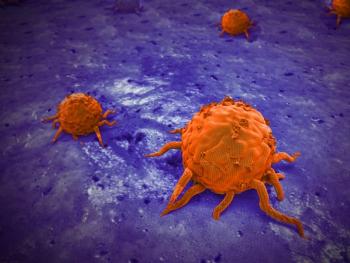
Oncology NEWS International
- Oncology NEWS International Vol 18 No 2
- Volume 18
- Issue 2
High-Dose Fulvestrant at Least as Good as Anastrozole in First-Line MBC
There is evidence that higher doses of fulvestrant (Faslodex) may have greater activity than the approved dose of 250 mg/mo. The FIRST trial (Fulvestrant First-Line Study) compared 500 mg vs anastrozole 1 mg/d in the first-line advanced disease setting, finding that a dose of 500 mg/mo achieved response rates and clinical benefit rates similar to those obtained with anastrozole 1 mg/d but gave a significantly longer time to progression (abstract 6126).
There is evidence that higher doses of fulvestrant (Faslodex) may have greater activity than the approved dose of 250 mg/mo. The FIRST trial (Fulvestrant First-Line Study) compared 500 mg vs anastrozole 1 mg/d in the first-line advanced disease setting, finding that a dose of 500 mg/mo achieved response rates and clinical benefit rates similar to those obtained with anastrozole 1 mg/d but gave a significantly longer time to progression (abstract 6126).
The multicenter open-label study randomized 205 postmenopausal advanced breast cancer patients to fulvestrant HD (two 250-mg injections) on or about days 0, 14, and 28, and monthly thereafter, or to 1 mg/d of oral anastrozole. For 75% of patients, this was the first line of treatment for advanced disease.
The investigator-determined response rates were 36% and 35.5%, respectively, in the fulvestrant and anastrozole arms. With fulvestrant HD, the clinical benefit rate (response plus stable disease for = 24 wk) was numerically higher at 72.5% vs 67% with anastrozole. Time to progression (TTP), however, was signifi cantly longer for fulvestrant HD, with a hazard ratio of 0.63 (P < .05). Median TTP had not been reached as compared with a median TTP of 12.5 months for anastrozole.
“At the data cutoff , 29.4% of patients treated with high-dose fulvestrant had progressed compared with 41.7% of those in the anastrozole group,” reported Matthew J. Ellis, MD, PhD.
Median duration of response and duration of clinical benefit both favored fulvestrant HD.
The fulvestrant HD regimen was well tolerated, with an adverse event profile comparable with that of anastrozole and consistent with that previously reported for the standard dose. The incidence of injection site pain with fulvestrant HD (5.9%) was similar to that seen with fulvestrant 250 mg (4.6%), despite there being twice as many injections per month in the HD regimen.
The ongoing phase III CONFIRM trial (Comparison of Fulvestrant in Recurrent or Metastatic Breast Cancer) is evaluating fulvestrant 500 mg vs 250 mg per month, which should help clarify the role of the higher dose, Dr. Ellis added.
Articles in this issue
over 16 years ago
Consortium advances multidisciplinary program for colon cancerover 16 years ago
Celator joins leukemia society for phase II trial of CPX-351over 16 years ago
Genzyme nabs FDA approval for stem cell mobilizing agentover 16 years ago
FDA launches pilot safety program for foreign drugsover 16 years ago
Radiation oncology society adopts new monikerover 16 years ago
Varian places RT units; offers storage systemover 16 years ago
Improvements in Pap screenings proposedover 16 years ago
New outlook for neuroendocrine cancerNewsletter
Stay up to date on recent advances in the multidisciplinary approach to cancer.


















































































